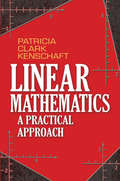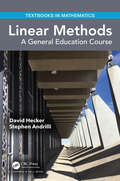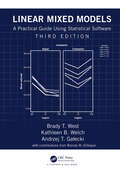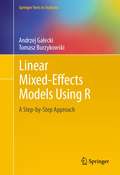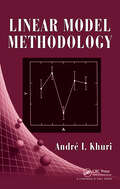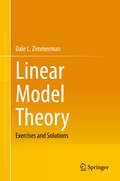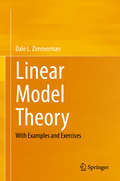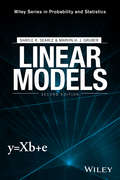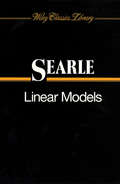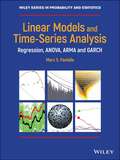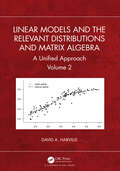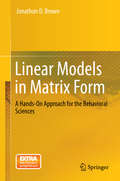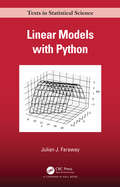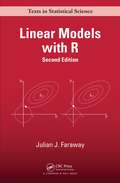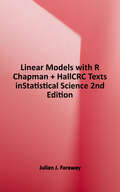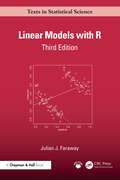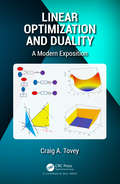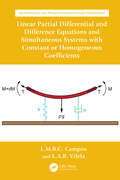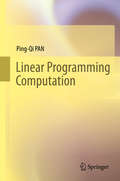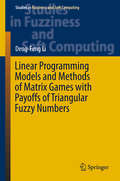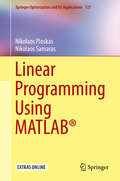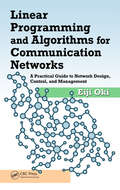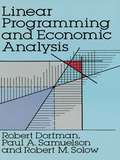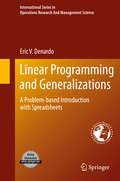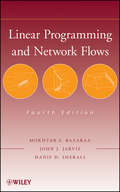- Table View
- List View
Linear Mathematics: A Practical Approach (Dover Books on Mathematics)
by Patricia Clark KenschaftDesigned to help students appreciate the beauty of abstract patterns and the thrill of modeling the "real" world, this versatile, time-tested, and widely used text requires only two years of high school algebra. Suitable for a traditional one-year course in linear algebra or a more streamlined single-semester course, it can also serve for courses in finite mathematics or mathematics in the contemporary world for liberal arts students. Carefully chosen examples and exercises form the basis of this treatment, in which students solve problems related to biology (nesting habits of birds), sociology (rural-urban migration patterns), transportation (traffic flow), psychology (verifying claims of ESP), business (maximizing profits), and other fields. Topics include matrices, Gauss-Jordan row operations, systems of linear equations without unique solutions, determinants, linear programming, the simplex algorithm, dual problems, probability, and game theory. Each chapter features sample tests with answers.
Linear Methods: A General Education Course (Textbooks in Mathematics)
by David Hecker Stephen AndrilliLinear Methods: A General Education Course is expressly written for non-mathematical students, particularly freshmen taking a required core mathematics course. Rather than covering a hodgepodge of different topics as is typical for a core mathematics course, this text encourages students to explore one particular branch of mathematics, elementary linear algebra, in some depth. The material is presented in an accessible manner, as opposed to a traditional overly rigorous approach. While introducing students to useful topics in linear algebra, the book also includes a gentle introduction to more abstract facets of the subject. Many relevant uses of linear algebra in today’s world are illustrated, including applications involving business, economics, elementary graph theory, Markov chains, linear regression and least-squares polynomials, geometric transformations, and elementary physics. The authors have included proofs of various important elementary theorems and properties which provide readers with the reasoning behind these results. Features: Written for a general education core course in introductory mathematics Introduces elementary linear algebra concepts to non-mathematics majors Provides an informal introduction to elementary proofs involving matrices and vectors Includes useful applications from linear algebra related to business, graph theory, regression, and elementary physics Authors Bio: David Hecker is a Professor of Mathematics at Saint Joseph's University in Philadelphia. He received his Ph.D. from Rutgers University and has published several journal articles. He also co-authored several editions of Elementary Linear Algebra with Stephen Andrilli. Stephen Andrilli is a Professor in the Mathematics and Computer Science Department at La Salle University in Philadelphia. He received his Ph.D. from Rutgers University and also co-authored several editions of Elementary Linear Algebra with David Hecker.
Linear Mixed Models: A Practical Guide Using Statistical Software
by Brady T. West Kathleen B. Welch Andrzej T GaleckiHighly recommended by JASA, Technometrics, and other leading statistical journals, the first two editions of this bestseller showed how to easily perform complex linear mixed model (LMM) analyses via a variety of software programs. Linear Mixed Models: A Practical Guide Using Statistical Software, Third Edition continues to lead readers step-by-step through the process of fitting LMMs. The third edition provides a comprehensive update of the available tools for fitting linear mixed-effects models in the newest versions of SAS, SPSS, R, Stata, and HLM. All examples have been updated, with a focus on new tools for visualization of results and interpretation. New conceptual and theoretical developments in mixed-effects modeling have been included, and there is a new chapter on power analysis for mixed-effects models. Features:•Dedicates an entire chapter to the key theories underlying LMMs for clustered, longitudinal, and repeated measures data•Provides descriptions, explanations, and examples of software code necessary to fit LMMs in SAS, SPSS, R, Stata, and HLM•Contains detailed tables of estimates and results, allowing for easy comparisons across software procedures•Presents step-by-step analyses of real-world data sets that arise from a variety of research settings and study designs, including hypothesis testing, interpretation of results, and model diagnostics•Integrates software code in each chapter to compare the relative advantages and disadvantages of each package•Supplemented by a website with software code, datasets, additional documents, and updates Ideal for anyone who uses software for statistical modeling, this book eliminates the need to read multiple software-specific texts by covering the most popular software programs for fitting LMMs in one handy guide. The authors illustrate the models and methods through real-world examples that enable comparisons of model-fitting options and results across the software procedures.
Linear Mixed-Effects Models Using R
by Tomasz Burzykowski Andrzej GałeckiLinear mixed-effects models (LMMs) are an important class of statistical models that can be used to analyze correlated data. Such data are encountered in a variety of fields including biostatistics, public health, psychometrics, educational measurement, and sociology. This book aims to support a wide range of uses for the models by applied researchers in those and other fields by providing state-of-the-art descriptions of the implementation of LMMs in R. To help readers to get familiar with the features of the models and the details of carrying them out in R, the book includes a review of the most important theoretical concepts of the models. The presentation connects theory, software and applications. It is built up incrementally, starting with a summary of the concepts underlying simpler classes of linear models like the classical regression model, and carrying them forward to LMMs. A similar step-by-step approach is used to describe the R tools for LMMs. All the classes of linear models presented in the book are illustrated using real-life data. The book also introduces several novel R tools for LMMs, including new class of variance-covariance structure for random-effects, methods for influence diagnostics and for power calculations. They are included into an R package that should assist the readers in applying these and other methods presented in this text.<P> Advisory: Bookshare has learned that this book offers only partial accessibility. We have kept it in the collection because it is useful for some of our members. To explore further access options with us, please contact us through the Book Quality link on the right sidebar. Benetech is actively working on projects to improve accessibility issues such as these.
Linear Model Methodology
by Andre I. KhuriGiven the importance of linear models in statistical theory and experimental research, a good understanding of their fundamental principles and theory is essential. Supported by a large number of examples, Linear Model Methodology provides a strong foundation in the theory of linear models and explores the latest developments in data analysis.After
Linear Model Theory: Exercises and Solutions
by Dale L. ZimmermanThis book contains 296 exercises and solutions covering a wide variety of topics in linear model theory, including generalized inverses, estimability, best linear unbiased estimation and prediction, ANOVA, confidence intervals, simultaneous confidence intervals, hypothesis testing, and variance component estimation. The models covered include the Gauss-Markov and Aitken models, mixed and random effects models, and the general mixed linear model. Given its content, the book will be useful for students and instructors alike. Readers can also consult the companion textbook Linear Model Theory - With Examples and Exercises by the same author for the theory behind the exercises.
Linear Model Theory: With Examples and Exercises
by Dale L. ZimmermanThis textbook presents a unified and rigorous approach to best linear unbiased estimation and prediction of parameters and random quantities in linear models, as well as other theory upon which much of the statistical methodology associated with linear models is based. The single most unique feature of the book is that each major concept or result is illustrated with one or more concrete examples or special cases. Commonly used methodologies based on the theory are presented in methodological interludes scattered throughout the book, along with a wealth of exercises that will benefit students and instructors alike. Generalized inverses are used throughout, so that the model matrix and various other matrices are not required to have full rank. Considerably more emphasis is given to estimability, partitioned analyses of variance, constrained least squares, effects of model misspecification, and most especially prediction than in many other textbooks on linear models. This book is intended for master and PhD students with a basic grasp of statistical theory, matrix algebra and applied regression analysis, and for instructors of linear models courses. Solutions to the book’s exercises are available in the companion volume Linear Model Theory - Exercises and Solutions by the same author.
Linear Models
by Shayle R. Searle Marvin H. GruberProvides an easy-to-understand guide to statistical linear models and its uses in data analysis This book defines a broad spectrum of statistical linear models that is useful in the analysis of data. Considerable rewriting was done to make the book more reader friendly than the first edition. Linear Models, Second Edition is written in such a way as to be self-contained for a person with a background in basic statistics, calculus and linear algebra. The text includes numerous applied illustrations, numerical examples, and exercises, now augmented with computer outputs in SAS and R. Also new to this edition is: * A greatly improved internal design and format * A short introductory chapter to ease understanding of the order in which topics are taken up * Discussion of additional topics including multiple comparisons and shrinkage estimators * Enhanced discussions of generalized inverses, the MINQUE, Bayes and Maximum Likelihood estimators for estimating variance components Furthermore, in this edition, the second author adds many pedagogical elements throughout the book. These include numbered examples, end-of-example and end-of-proof symbols, selected hints and solutions to exercises available on the book's website, and references to "big data" in everyday life. Featuring a thorough update, Linear Models, Second Edition includes: * A new internal format, additional instructional pedagogy, selected hints and solutions to exercises, and several more real-life applications * Many examples using SAS and R with timely data sets * Over 400 examples and exercises throughout the book to reinforce understanding Linear Models, Second Edition is a textbook and a reference for upper-level undergraduate and beginning graduate-level courses on linear models, statisticians, engineers, and scientists who use multiple regression or analysis of variance in their work. SHAYLE R. SEARLE, PhD, was Professor Emeritus of Biometry at Cornell University. He was the author of the first edition of Linear Models, Linear Models for Unbalanced Data, and Generalized, Linear, and Mixed Models (with Charles E. McCulloch), all from Wiley. The first edition of Linear Models appears in the Wiley Classics Library. MARVIN H. J. GRUBER, PhD, is Professor Emeritus at Rochester Institute of Technology, School of Mathematical Sciences. Dr. Gruber has written a number of papers and has given numerous presentations at professional meetings during his tenure as a professor at RIT. His fields of interest include regression estimators and the improvement of their efficiency using shrinkage estimators. He has written and published two books on this topic. Another of his books, Matrix Algebra for Linear Models, also published by Wiley, provides good preparation for studying Linear Models. He is a member of the American Mathematical Society, the Institute of Mathematical Statistics and the American Statistical Association.
Linear Models
by Shayle R. SearleThis 1971 classic on linear models is once again available--as a Wiley Classics Library Edition. It features material that can be understood by any statistician who understands matrix algebra and basic statistical methods.
Linear Models and Time-Series Analysis: Regression, ANOVA, ARMA and GARCH (Wiley Series in Probability and Statistics #8)
by Marc S. PaolellaA comprehensive and timely edition on an emerging new trend in time series Linear Models and Time-Series Analysis: Regression, ANOVA, ARMA and GARCH sets a strong foundation, in terms of distribution theory, for the linear model (regression and ANOVA), univariate time series analysis (ARMAX and GARCH), and some multivariate models associated primarily with modeling financial asset returns (copula-based structures and the discrete mixed normal and Laplace). It builds on the author's previous book, Fundamental Statistical Inference: A Computational Approach, which introduced the major concepts of statistical inference. Attention is explicitly paid to application and numeric computation, with examples of Matlab code throughout. The code offers a framework for discussion and illustration of numerics, and shows the mapping from theory to computation. The topic of time series analysis is on firm footing, with numerous textbooks and research journals dedicated to it. With respect to the subject/technology, many chapters in Linear Models and Time-Series Analysis cover firmly entrenched topics (regression and ARMA). Several others are dedicated to very modern methods, as used in empirical finance, asset pricing, risk management, and portfolio optimization, in order to address the severe change in performance of many pension funds, and changes in how fund managers work. Covers traditional time series analysis with new guidelines Provides access to cutting edge topics that are at the forefront of financial econometrics and industry Includes latest developments and topics such as financial returns data, notably also in a multivariate context Written by a leading expert in time series analysis Extensively classroom tested Includes a tutorial on SAS Supplemented with a companion website containing numerous Matlab programs Solutions to most exercises are provided in the book Linear Models and Time-Series Analysis: Regression, ANOVA, ARMA and GARCH is suitable for advanced masters students in statistics and quantitative finance, as well as doctoral students in economics and finance. It is also useful for quantitative financial practitioners in large financial institutions and smaller finance outlets.
Linear Models and the Relevant Distributions and Matrix Algebra: A Unified Approach Volume 2
by David A. HarvilleLinear Models and the Relevant Distributions and Matrix Algebra: A Unified Approach, Volume 2 covers several important topics that were not included in the first volume. The second volume complements the first, providing detailed solutions to the exercises in both volumes, thereby greatly enhancing its appeal for use in advanced statistics programs. This volume can serve as a valuable reference. It can also serve as a resource in a mathematical statistics course for use in illustrating various theoretical concepts in the context of a relatively complex setting of great practical importance. Together with the first volume, this volume provides a largely self-contained treatment of an important area of statistics and should prove highly useful to graduate students and others. Key Features: Includes solutions to the exercises from both the first and second volumes Includes coverage of several topics not covered in the first volume Highly valuable as a reference book for graduate students and researchers
Linear Models in Matrix Form
by Jonathon D. BrownThis textbook is an approachable introduction to statistical analysis using matrix algebra. Prior knowledge of matrix algebra is not necessary. Advanced topics are easy to follow through analyses that were performed on an open-source spreadsheet using a few built-in functions. These topics include ordinary linear regression, as well as maximum likelihood estimation, matrix decompositions, nonparametric smoothers and penalized cubic splines. Each data set (1) contains a limited number of observations to encourage readers to do the calculations themselves, and (2) tells a coherent story based on statistical significance and confidence intervals. In this way, students will learn how the numbers were generated and how they can be used to make cogent arguments about everyday matters. This textbook is designed for use in upper level undergraduate courses or first year graduate courses. The first chapter introduces students to linear equations, then covers matrix algebra, focusing on three essential operations: sum of squares, the determinant, and the inverse. These operations are explained in everyday language, and their calculations are demonstrated using concrete examples. The remaining chapters build on these operations, progressing from simple linear regression to mediational models with bootstrapped standard errors.
Linear Models with Python (Chapman & Hall/CRC Texts in Statistical Science)
by Julian J. FarawayPraise for Linear Models with R: This book is a must-have tool for anyone interested in understanding and applying linear models. The logical ordering of the chapters is well thought out and portrays Faraway’s wealth of experience in teaching and using linear models. … It lays down the material in a logical and intricate manner and makes linear modeling appealing to researchers from virtually all fields of study. -Biometrical Journal Throughout, it gives plenty of insight … with comments that even the seasoned practitioner will appreciate. Interspersed with R code and the output that it produces one can find many little gems of what I think is sound statistical advice, well epitomized with the examples chosen…I read it with delight and think that the same will be true with anyone who is engaged in the use or teaching of linear models. -Journal of the Royal Statistical Society Like its widely praised, best-selling companion version, Linear Models with R, this book replaces R with Python to seamlessly give a coherent exposition of the practice of linear modeling. Linear Models with Python offers up-to-date insight on essential data analysis topics, from estimation, inference and prediction to missing data, factorial models and block designs. Numerous examples illustrate how to apply the different methods using Python. Features: Python is a powerful, open source programming language increasingly being used in data science, machine learning and computer science. Python and R are similar, but R was designed for statistics, while Python is multi-talented. This version replaces R with Python to make it accessible to a greater number of users outside of statistics, including those from Machine Learning. A reader coming to this book from an ML background will learn new statistical perspectives on learning from data. Topics include Model Selection, Shrinkage, Experiments with Blocks and Missing Data. Includes an Appendix on Python for beginners. Linear Models with Python explains how to use linear models in physical science, engineering, social science and business applications. It is ideal as a textbook for linear models or linear regression courses.
Linear Models with R (Chapman & Hall/CRC Texts in Statistical Science)
by Julian J. FarawayA Hands-On Way to Learning Data AnalysisPart of the core of statistics, linear models are used to make predictions and explain the relationship between the response and the predictors. Understanding linear models is crucial to a broader competence in the practice of statistics. Linear Models with R, Second Edition explains how to use linear models
Linear Models with R (Chapman & Hall/CRC Texts in Statistical Science)
by Julian J. FarawayA Hands-On Way to Learning Data Analysis <p><p> Part of the core of statistics, linear models are used to make predictions and explain the relationship between the response and the predictors. Understanding linear models is crucial to a broader competence in the practice of statistics. Linear Models with R, Second Edition explains how to use linear models in physical science, engineering, social science, and business applications. The book incorporates several improvements that reflect how the world of R has greatly expanded since the publication of the first edition. <p><p> New to the Second Edition <p><p> <p>•Reorganized material on interpreting linear models, which distinguishes the main applications of prediction and explanation and introduces elementary notions of causality <p>•Additional topics, including QR decomposition, splines, additive models, Lasso, multiple imputation, and false discovery rates <p>•Extensive use of the ggplot2 graphics package in addition to base graphics <p><p>Like its widely praised, best-selling predecessor, this edition combines statistics and R to seamlessly give a coherent exposition of the practice of linear modeling. The text offers up-to-date insight on essential data analysis topics, from estimation, inference, and prediction to missing data, factorial models, and block designs. Numerous examples illustrate how to apply the different methods using R.
Linear Models with R (Chapman & Hall/CRC Texts in Statistical Science)
by Julian J. FarawayA Hands-On Way to Learning Data AnalysisPart of the core of statistics, linear models are used to make predictions and explain the relationship between the response and the predictors. Understanding linear models is crucial to a broader competence in the practice of statistics. Linear Models with R, Third Edition explains how to use linear models in physical science, engineering, social science, and business applications. The book incorporates several improvements that reflect how the world of R has greatly expanded since the publication of the second edition.New to the Third Edition 40% more content with more explanation and examples throughout New chapter on sampling featuring simulation-based methods Model assessment methods discussed Explanation chapter expanded to include introductory ideas about causation Model interpretation in the presence of transformation Crossvalidation for model selection Chapter on regularization now includes the elastic net More on multiple comparisons and the use of marginal means Discussion of design and power Like its widely praised, best-selling predecessor, this edition combines statistics and R to seamlessly give a coherent exposition of the practice of linear modeling. The text offers up-to-date insight on essential data analysis topics, from estimation, inference, and prediction to missing data, factorial models, and block designs. Numerous examples illustrate how to apply the different methods using R.
Linear Optimization and Duality: A Modern Exposition
by Craig A. ToveyLinear Optimization and Dualiyy: A Modern Exposition departs from convention in significant ways. Standard linear programming textbooks present the material in the order in which it was discovered. Duality is treated as a difficult add-on after coverage of formulation, the simplex method, and polyhedral theory. Students end up without knowing duality in their bones. This text brings in duality in Chapter 1 and carries duality all the way through the exposition. Chapter 1 gives a general definition of duality that shows the dual aspects of a matrix as a column of rows and a row of columns. The proof of weak duality in Chapter 2 is shown via the Lagrangian, which relies on matrix duality. The first three LP formulation examples in Chapter 3 are classic primal-dual pairs including the diet problem and 2-person zero sum games. For many engineering students, optimization is their first immersion in rigorous mathematics. Conventional texts assume a level of mathematical sophistication they don’t have. This text embeds dozens of reading tips and hundreds of answered questions to guide such students. Features Emphasis on duality throughout Practical tips for modeling and computation Coverage of computational complexity and data structures Exercises and problems based on the learning theory concept of the zone of proximal development Guidance for the mathematically unsophisticated reader About the Author Craig A. Tovey is a professor in the H. Milton Stewart School of Industrial and Systems Engineering at Georgia Institute of Technology. Dr. Tovey received an AB from Harvard College, an MS in computer science and a PhD in operations research from Stanford University. His principal activities are in operations research and its interdisciplinary applications. He received a Presidential Young Investigator Award and the Jacob Wolfowitz Prize for research in heuristics. He was named an Institute Fellow at Georgia Tech, and was recognized by the ACM Special Interest Group on Electronic Commerce with the Test of Time Award. Dr. Tovey received the 2016 Golden Goose Award for his research on bee foraging behavior leading to the development of the Honey Bee Algorithm.
Linear Partial Differential and Difference Equations and Simultaneous Systems with Constant or Homogeneous Coefficients (Mathematics and Physics for Science and Technology)
by Luis Manuel Braga da Costa Campos Luís António Raio VilelaLinear Partial Differential and Difference Equations and Simultaneous Systems: With Constant or Homogeneous Coefficients is part of the series "Mathematics and Physics for Science and Technology," which combines rigorous mathematics with general physical principles to model practical engineering systems with a detailed derivation and interpretation of results. Volume V presents the mathematical theory of partial differential equations and methods of solution satisfying initial and boundary conditions, and includes applications to: acoustic, elastic, water, electromagnetic and other waves; the diffusion of heat, mass, and electricity; and their interactions. This is the third book of the volume.The book starts with six different methods of solution of linear partial differential equations (p.d.e.) with constant coefficients. One of the methods, namely characteristic polynomial, is then extended to a further five classes, including linear p.d.e. with homogeneous power coefficients and finite difference equations and simultaneous systems of both (simultaneous partial differential equations [s.p.d.e.] and simultaneous finite difference equations [s.f.d.e.]). The applications include detailed solutions of the most important p.d.e. in physics and engineering, including the Laplace, heat, diffusion, telegraph, bar, and beam equations. The free and forced solutions are considered together with boundary, initial, asymptotic, starting, and other conditions.The book is intended for graduate students and engineers working with mathematical models and can be applied to problems in mechanical, aerospace, electrical, and other branches of engineering dealing with advanced technology, and also in the physical sciences and applied mathematics.
Linear Programming Computation
by Ping-Qi PanWith emphasis on computation, this book is a real breakthrough in the field of LP. In addition to conventional topics, such as the simplex method, duality, and interior-point methods, all deduced in a fresh and clear manner, it introduces the state of the art by highlighting brand-new and advanced results, including efficient pivot rules, Phase-I approaches, reduced simplex methods, deficient-basis methods, face methods, and pivotal interior-point methods. In particular, it covers the determination of the optimal solution set, feasible-point simplex method, decomposition principle for solving large-scale problems, controlled-branch method based on generalized reduced simplex framework for solving integer LP problems.
Linear Programming Models and Methods of Matrix Games with Payoffs of Triangular Fuzzy Numbers
by Deng-Feng LiThis book addresses two-person zero-sum finite games in which the payoffs in any situation are expressed with fuzzy numbers. The purpose of this book is to develop a suite of effective and efficient linear programming models and methods for solving matrix games with payoffs in fuzzy numbers. Divided into six chapters, it discusses the concepts of solutions of matrix games with payoffs of intervals, along with their linear programming models and methods. Furthermore, it is directly relevant to the research field of matrix games under uncertain economic management. The book offers a valuable resource for readers involved in theoretical research and practical applications from a range of different fields including game theory, operational research, management science, fuzzy mathematical programming, fuzzy mathematics, industrial engineering, business and social economics.
Linear Programming Using MATLAB® (Springer Optimization and Its Applications #127)
by Nikolaos Ploskas Nikolaos SamarasThis book offers a theoretical and computational presentation of a variety of linear programming algorithms and methods with an emphasis on the revised simplex method and its components. A theoretical background and mathematical formulation is included for each algorithm as well as comprehensive numerical examples and corresponding MATLAB#65533; code. The MATLAB#65533; implementations presented in this book are sophisticated and allow users to find solutions to large-scale benchmark linear programs. Each algorithm is followed by a computational study on benchmark problems that analyze the computational behavior of the presented algorithms. As a solid companion to existing algorithmic-specific literature, this book will be useful to researchers, scientists, mathematical programmers, and students with a basic knowledge of linear algebra and calculus. The clear presentation enables the reader to understand and utilize all components of simplex-type methods, such as presolve techniques, scaling techniques, pivoting rules, basis update methods, and sensitivity analysis.
Linear Programming and Algorithms for Communication Networks: A Practical Guide to Network Design, Control, and Management
by Eiji OkiExplaining how to apply to mathematical programming to network design and control, Linear Programming and Algorithms for Communication Networks: A Practical Guide to Network Design, Control, and Management fills the gap between mathematical programming theory and its implementation in communication networks. From the basics all the way through to m
Linear Programming and Economic Analysis (Dover Books on Computer Science)
by Paul A. Samuelson Robert M. Solow Robert DorfmanDesigned primarily for economists and those interested in management economics who are not necessarily accomplished mathematicians, this text offers a clear, concise exposition of the relationship of linear programming to standard economic analysis. The research and writing were supported by The RAND Corporation in the late 1950s.Linear programming has been one of the most important postwar developments in economic theory, but until publication of the present volume, no text offered a comprehensive treatment of the many facets of the relationship of linear programming to traditional economic theory. This book was the first to provide a wide-ranging survey of such important aspects of the topic as the interrelations between the celebrated von Neumann theory of games and linear programming, and the relationship between game theory and the traditional economic theories of duopoly and bilateral monopoly.Modern economists will especially appreciate the treatment of the connection between linear programming and modern welfare economics and the insights that linear programming gives into the determinateness of Walrasian equilibrium. The book also offers an excellent introduction to the important Leontief theory of input-output as well as extensive treatment of the problems of dynamic linear programming. Successfully used for three decades in graduate economics courses, this book stresses practical problems and specifies important concrete applications.
Linear Programming and Generalizations
by Eric V. DenardoThis book on constrained optimization is novel in that it fuses these themes: * use examples to introduce general ideas; * engage the student in spreadsheet computation; * survey the uses of constrained optimization;. * investigate game theory and nonlinear optimization, * link the subject to economic reasoning, and * present the requisite mathematics. Blending these themes makes constrained optimization more accessible and more valuable. It stimulates the student's interest, quickens the learning process, reveals connections to several academic and professional fields, and deepens the student's grasp of the relevant mathematics. The book is designed for use in courses that focus on the applications of constrained optimization, in courses that emphasize the theory, and in courses that link the subject to economics.
Linear Programming and Network Flows
by Hanif D. Sherali Mokhtar S. Bazaraa John J. JarvisThe authoritative guide to modeling and solving complex problems with linear programming--extensively revised, expanded, and updatedThe only book to treat both linear programming techniques and network flows under one cover, Linear Programming and Network Flows, Fourth Edition has been completely updated with the latest developments on the topic. This new edition continues to successfully emphasize modeling concepts, the design and analysis of algorithms, and implementation strategies for problems in a variety of fields, including industrial engineering, management science, operations research, computer science, and mathematics.The book begins with basic results on linear algebra and convex analysis, and a geometrically motivated study of the structure of polyhedral sets is provided. Subsequent chapters include coverage of cycling in the simplex method, interior point methods, and sensitivity and parametric analysis. Newly added topics in the Fourth Edition include:The cycling phenomenon in linear programming and the geometry of cyclingDuality relationships with cyclingElaboration on stable factorizations and implementation strategiesStabilized column generation and acceleration of Benders and Dantzig-Wolfe decomposition methodsLine search and dual ascent ideas for the out-of-kilter algorithmHeap implementation comments, negative cost circuit insights, and additional convergence analyses for shortest path problemsThe authors present concepts and techniques that are illustrated by numerical examples along with insights complete with detailed mathematical analysis and justification. An emphasis is placed on providing geometric viewpoints and economic interpretations as well as strengthening the understanding of the fundamental ideas. Each chapter is accompanied by Notes and References sections that provide historical developments in addition to current and future trends. Updated exercises allow readers to test their comprehension of the presented material, and extensive references provide resources for further study.Linear Programming and Network Flows, Fourth Edition is an excellent book for linear programming and network flow courses at the upper-undergraduate and graduate levels. It is also a valuable resource for applied scientists who would like to refresh their understanding of linear programming and network flow techniques.
